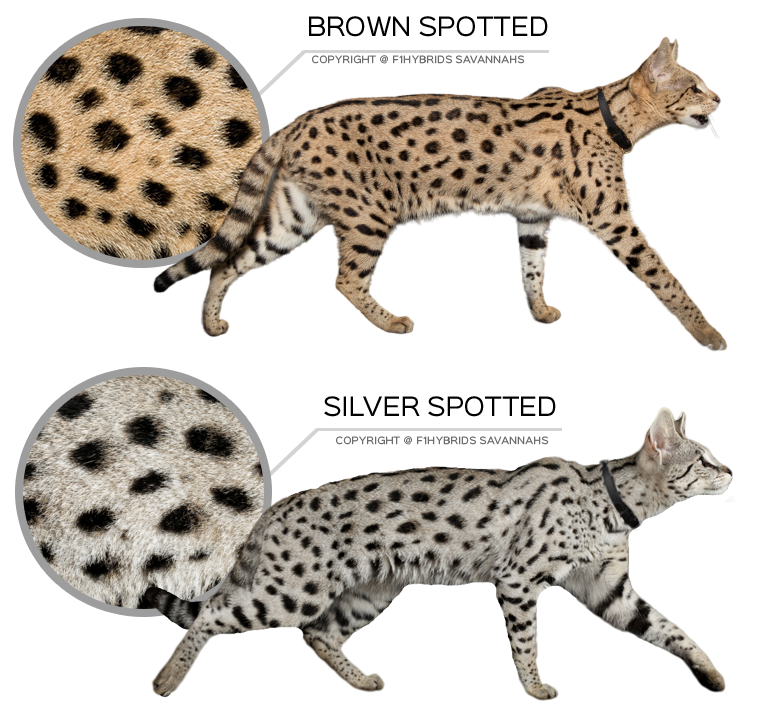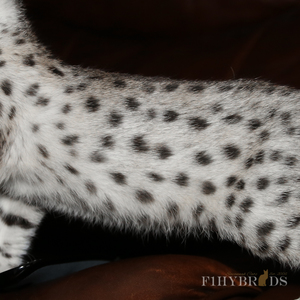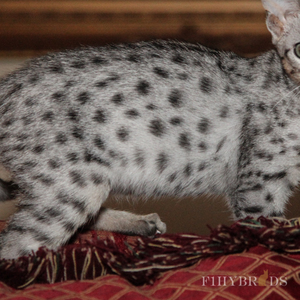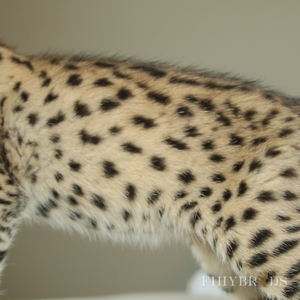Savannah Cat Patterns
Savannah Cats Pattern is spotted only which is the only accepted by TICA. Solid one-color spots are the only pattern found on the African Serval Cat, due to this fact Spots are the pattern acceptable. The spots should follow across the body and not be connected.
Pictures are of correct horizontal spotting pattern!
Non-standard patterns are recessive domestic patterns. Nothing is wrong with breeding a non-standard patterns if said cat posses above average breed type. If the cat is only average breed confirmation with non-standard quality then it should not be in a breeding program. The following statement is an example of "selling" non-standard patterns. Rosettes are non-standard because Serval Cats do not have rosettes. If you desire rosettes they are a approved Bengal pattern.
F2 Savannah Kitten Showing Horizontal Pattern
Ocelli Ear Mark
Ocelli Ear Mark is a round light-colored spot on the back of the ears. Although very common in wild cat this marking can be found throught nature, most commonly on the wings of butterflies. Serval Cats have an "ocelli" marking behind the ears which are high-contrast marks that are thought to scare off predators by mimicking the eyes of the predators' own enemies. Savannah Cats inherit this marking from the Serval Cat however it is often a muted version with less contrast. Typically lacking the high contrast of black with white color combination. It is considered desirable to have black with white but not a fault to have lesser contrasting colors (black with brown, brown with brown).
Non-Standard Coat Traits
White toes
White lockets of hair
Blue eyes
Marble pattern
Servaline pattern
Ticked pattern
Long hair
Curly hair
Hairless
Expression Of White
Expression of solid white and larger patches of white should not be present on a Savannah Cat and will result in a penalty within the show ring but not a disqualification. It is thought that white servals may be the result of white being expressed on the coat as illustrated in the below diagram. Although this is possibly true it is also a known fact that such serval cats have never existed in the wild and have happened a few select times due to inbreeding in captivity. All the Serval Cats pictured below were produced by inbred bloodlines. The all-white serval on the far right developed a tumor on his nose (thought to be due to the pink pigment on the nose) and it had to be removed.
Servaline Pattern
Here we have two wild Serval Cats from the same region with different patterns. Servaline (ticked pattern) on the left, you can see what looks like the beginnings of two-toned rosettes (no definite outline). Certainly, this would be considered a one-off pattern without more evidence. The ticked Servaline pattern with only one color has been documented in the wild. On right, we see the traditional spotted pattern. The Serval on the right is likely male considering his thick cheeks and overall thicker body.
Notice the flow of solid spots on this F1 Savannah Cat










